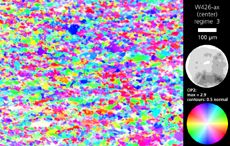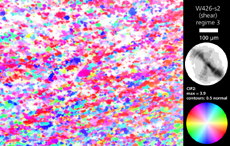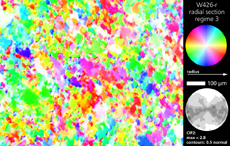4.6
ORIENTATION IMAGES OF EXPERIMENTALLY DEFORMED ROCKS
top / contents / section 4 / pages -- 4.1 -- 4.2 -- 4.3 -- 4.4 -- 4.5 -- 4.6 -- 4.7
Making use of sample heterogeneity



Axial thin sections of experimentally deformed rock samples (typically cylinders of 6 mm diameter) constitute planar volumes of approximately orthorhombic or even lower symmetry. In the center of a homogeneously shortened cylinder, the predominant mass flux is in a radial direction, near the periphery, it is tangential; accordingly, on the thin section, the strain ellipse is elongated radially near the center and isotropic or elongated axially near the periphery. The strain history of each subvolume depends on its distance from the central axis, the amount of axial compression, and the type and concentration of deformation at that point. High concentrations of pure shear occur in the central part of the rock cylinder, away from the pistons. Near the piston-specimen interfaces, conical zones of high intensity shearing may occur
On axial and radial sections, a number of different and interesting textures and microstructures can be observed. It is argued that the comparison between the textures of naturally and experimentally deformed rocks has to relie on the analysis of local textures and microstructures: significant information is lost if bulk textures or profiles are used (Heilbronner & Tullis, 1999).
Experimental conditions:
Material: Black Hills quartzite
(regime 3 of dislocation creep)
- pc = 1.5 GPa
- T = 1200°C
- strain rate = 10-5 s-1
- dry
Left, from top to bottom:
- W426C, site 1, predominantly pure shear
- W426S, site 2, predominantly simple shear
- W426R, site 3, radial section
- view of thin sections, frames from left to right denote sites 1, 2, 3 of thin sections

